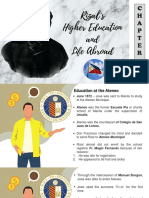Rizal - Module 4
Rizal - Module 4
Uploaded by
priagolavinchentCopyright:
Available Formats
Rizal - Module 4
Rizal - Module 4
Uploaded by
priagolavinchentOriginal Title
Copyright
Available Formats
Share this document
Did you find this document useful?
Is this content inappropriate?
Copyright:
Available Formats
Rizal - Module 4
Rizal - Module 4
Uploaded by
priagolavinchentCopyright:
Available Formats
CHAPTER 4
Scholastic Triumphs at Ateneo de Manila (1872-1877)
Chapter Summary
Four months after the martyrdom of Gom-Bur-Za and with Four months after the
martyrdom of Gom-Bur-Za and with Doña Teodora still in prison, Jose, who had not yet
celebrated his eleventh birthday, was sent to manila. He studied in the Ateneo Municipal, a
college under the supervision of the Spanish Jesuits. This college was a bitter rival of the
Dominican-owned College of San Juan de Letran. It was formerly the Escuela Pia (Charity
School) a school for poor boys in manila which was established by the city government in 1817.
When the Jesuits, who had been expelled from the Philippines in 1768, returned to manila in
1859, they were given the management of the Escuela Pia, whose name was changed to Ateneo
de Manila. They were splendid educators, so that Ateneo acquired prestige as an excellent
college for boys.
Outline:
Rizal enters the Ateneo
Jesuit system of education
Rizal’s first year in Ateneo (1872-73)
Summer vacation (1873)
Second year in Ateneo (1873-74)
DISCUSSION:
Rizal enters the Ateneo. On June 10, 1872 Jose, accompanied by Paciano, went to Manila. He
took the entrance examinations on Christian doctrine, arithmetic, and reading at the College of
San Juna de Letran, and passed them. He returned to Calamba to stay a few days with his family
and to attend the town fiesta. His father, who first wished him to study at Letran, changed his
mind and decided to send him to Ateneo instead.
Thus, upon his return to Manila, Jose, again accompanied by Paciano, matriculated at the
Ateneo Municipal. At first, Father Magin Ferrando, who was the college registrar, refused to
admit him for two reasons: (1) he was late for registration and (2) he was sickly and undersized
for his age. Rizal was then eleven years old. However, upon the intercession of Manuel Xerez
Burgos, nephew of Father Burgos, he was reluctantly admitted at the Ateneo.
Jose was the first of his family to adopt the surname “Rizal.” He registered under this
name in Ateneo because their family name “Mercado” had come under the suspicion of the
Spanish authorities. Paciano had used “Mercado” as his surname at the College of Sab Jose and
he was known to the authorities as Father Burgos’ favorite student and confidant.
At the time Jose studied in the Ateneo, this College was located in Intramuros, on
Caraballo Street, 25 minutes’ walk from the college. This boarding house was owned by a
spinster named Titay who owed Rizal family the amount of P300. Jose boarded with her in order
to collect part of the debt.
Jesuit system of education.The system of education given by the Jesuits in the Ateneo was
more advanced than that of other colleges in that period. It trained the character of the student by
rigid discipline and religious instruction. It promoted physical culture, humanities, and scientific
studies. Aside from academic courses leading to the degree of Bachelor of Arts, it offered
vocational courses in agriculture, commerce, mechanics, and surveying.
The students heard Mass in the morning before the beginning of the daily class. Classes
in every subject were opened and closed with prayers.
Students were divided into two groups, namely:
1. Roman Empire – consisting of the internos (boarders)
2. Carthaginian Empire – composed of externos (non-boarders)
Each of these empires had its ranks:
Emperor – the best student in each empire
Tribune – the second best
Decurion – the third best
Centurion – the fourth best
Standard-Bearer - the fifth best
Within the “empire”, the students fought for positions, any student could challenge any
officer in his “empire” to answer questions on the day’s lesson. His opponent could lose his
position if he committed three mistakes. Any student might be at the end of the line, but if he
studied hard and was brilliant, he could depose the officers one after another and become an
emperor.
The two groups, “Roman Empire” and “Carthaginian Empire,” were in constant
competition for supremacy in the class. They had their distinctive banners: red for the Romans
and blue for the Carthaginians. At the beginning of the school term, both banners were used
equally in the classroom. “Upon the first defeat, the banner of losing party was transferred to the
left side of the room. Upon the second, it was placed in the inferior position on the right side.
Upon the third, the inclined flag was placed on the left. Upon the fourth, the flag was reversed
and returned to the right. Upon the fifth, the reversed flag was placed on the left. Upon the sixth,
the banner was changed with a figure of a donkey.”
The Ateneo students in Rizal’s time wore a uniform which consisted of “hemp-fabric
trousers” and “stripped cotton coat.” The coat material was called rayadillo, which later became
famous for it was adopted as the uniform for Filipino troops during the days of the First
Philippine Republic.
Rizal’s first year in Ateneo (1872-73). On his first day of class in Ateneo, in June 1872,
Rizal first heard Mass at the college chapel and prayed fervently to God for guidance and
success. When the Mass was finished, he went to his class, where he saw great number of boys,
Spaniards, mestizos and Filipinos.
Rizal first professor in Ateneo was Fr. Jose Bech, whom he described as a “tall, thin man,
with a body slightly bent forward, a harried walk, an ascetic face, severe and inspired, small
deep-sunken eyes, a sharp nose that was almost Greek, and thin lips forming an arc whose ends
fell toward the chin.”
Summer Vacation (1873). At the end of the school year in March, 1873, Rizal returned
to Calamba for summer vacation. He did not particularly enjoy his vacation because his mother
wan is prison. To cheer him up, his sister Neneng (Saturnina) brought him to Tanawan with her.
This did not cure his melancholy. Without telling his father, he went to Santa Cruz and visited
his mother in prison. He told her of his brilliant grades at the Ateneo. She gladly embraced her
favorite son.
When summer vacation was ended, Rizal returned to Manila for his second year term in
Ateneo. This time he boarded inside Intramuros at No. 6 Magallanes Street. His landlady was an
old lady named Doña Pepay, who had a widowed daughter and four sons.
Second year in Ateneo (1873-74).Nothing unusual happened to Rizal during his second
term in Ateneo, except that he repented having neglected his studies the previous year simply
because he was offended by the teacher’s remarks. So, to regain his lost class leadership, he
studied harder. Once more he become “emperor”.
Prophecy of Mother’s release.Rizal lost no time in going to Santa Cruz in order to visit
his mother in the provincial jail. He cheered up Doña Teodora’s lonely heart with news of his
scholastic triumphs in Ateneo and with funny tales about his professors and fellow students. The
mother was very happy to know that her favorite child was making such splendid progress in
college.
In the course of their conviction, Doña Teodora told her son of her dream the previous
night. Rizal interpreting the dream told her that she would be released from prison in three
months’ time. Doña Teodora smiled, thinking that her son’s prophecy was a mere boyish attempt
to console her.
But Rizal’s prophecy became true. Barely three months passed, and suddenly Doña
Teodora was set free. By that time, Rizal was already in Manila attending his classes in Ateneo.
Doña Teodora, happily back in Calamba, was even more proud of her son Jose whom she
likened to the youthful Joseph in the Bible in his ability to interpret dreams.
First romance of Rizal.Shortly after his graduation from the Ateneo, Rizal, who was
then sixteen years old, experienced his first romance – “that painful experience which comes to
nearly all adolescents”. The girl was Segunda Katigbak, a pretty fourteen-year old Batangueña
from Lipa. In Rizal’s own words: “She was rather short, with eyes that were eloquent and ardent
at times and languid at others, rosy-cheeked, with an enchanting and provocative smile that
revealed very beautiful teeth, and the air of a sylph; her entire self-diffused a mysterious charm.”
One Sunday Rizal visited his maternal grandmother who lived in Trozo, Manila. He was
accompanied by his friend, Mariano Katigbak. His old grandmother was a friend of the Katigbak
family of Lipa. When he reached his grandmother’s house, he saw guests. One of whom was an
attractive girl, who mysteriously caused his heart to palpitate with strange ecstasy. She was the
sister of his friend Mariano, and her name was Segunda.
Chapter Test
1. Who accompanied Rizal in his visit to his maternal grandmother in Trozo, Manila?
Answer:
2. He is one of rizal’s contemporaries in the Ateneo. He related an incident of Rizal’s
schooldays in the Ateneo which reveals the hero’s resignation to pain and forgiveness.
Answer:
3. This book was written by Dr. Feodor Jagor which read and impressed him?
Answer:
4. In Rizal’s 5th day and last year in the Ateneo, he was the most brilliant Atenean of his
time and was called at the time the…?
Answer:
5. The hero of “The Count of Monte Cristo?
Answer:
6. He was a professor who advise Rizal to stop communing with the Muses and pay more
attention to more practical studies, such as philosophy and natural sciences. Rizal not
heed his advise?
Answer:
7. Escuela Pia-Ateneo Municipal is?
Answer:
8. Where did Rizal’s maternal grandmother live?
Answer:
9. The college registrar of Ateneo municipal who refused to admit Rizal in the College?f
Answer:
10. How many mistakes would it take for a student who is challenged by another student to
lose his position?
Answer:
You might also like
- Jose Rizal's Higher Education and Life AbroadDocument15 pagesJose Rizal's Higher Education and Life AbroadDominic Mozo86% (7)
- Rizal Enters The AteneoDocument5 pagesRizal Enters The Ateneolvictorio_191% (11)
- Sps Miraflores Vs OMBDocument3 pagesSps Miraflores Vs OMBJayson Racal100% (1)
- Request Letter - CIDG Police AssistanceDocument2 pagesRequest Letter - CIDG Police AssistanceJazz TraceyNo ratings yet
- Rhetorical Analysis Schalk-1-1Document6 pagesRhetorical Analysis Schalk-1-1api-375859724No ratings yet
- Chapter 4Document11 pagesChapter 4Bermejo, Rhona Rose C.No ratings yet
- Chapter 4-5Document13 pagesChapter 4-5Shaina Marie GaroNo ratings yet
- Chapter 4 Latest Oct. 14Document11 pagesChapter 4 Latest Oct. 14JessaNo ratings yet
- Chapter 4Document14 pagesChapter 4Irish Bianca Usob LunaNo ratings yet
- Rizal's Life in AteneoDocument3 pagesRizal's Life in AteneoAna HakuraNo ratings yet
- Rizal - Life & Works of Rizal Module 4Document8 pagesRizal - Life & Works of Rizal Module 4Francis John OgayonNo ratings yet
- Chapter 4 Life and Works of Jose RizalDocument6 pagesChapter 4 Life and Works of Jose RizalElla Marie MostralesNo ratings yet
- Handout - Group 2Document6 pagesHandout - Group 2Suzy LeeNo ratings yet
- Week 6 - Balidio Joeylyn S.Document5 pagesWeek 6 - Balidio Joeylyn S.Joeylyn BalidioNo ratings yet
- Life and Works of Rizal Chap 4Document5 pagesLife and Works of Rizal Chap 4Mhayrhell Molina ArriolaNo ratings yet
- Chapter Summary: Chapter 4: Scholastic Triumphs at Ateneo de Manila (1872-1877)Document31 pagesChapter Summary: Chapter 4: Scholastic Triumphs at Ateneo de Manila (1872-1877)Monina AmanoNo ratings yet
- Documents Analysis Worksheet "Rizal's Life: Higher Education and Life Abroad" "La Solidaridad"Document11 pagesDocuments Analysis Worksheet "Rizal's Life: Higher Education and Life Abroad" "La Solidaridad"JamilaNo ratings yet
- Rizal Life Higher Education and Life AbroadDocument20 pagesRizal Life Higher Education and Life AbroadElizabeth Sarmiento LasalitaNo ratings yet
- Lesson 5Document2 pagesLesson 5Jan Mark CastilloNo ratings yet
- Rizal's Years at The Ateneo Municipal de College de ManilaDocument66 pagesRizal's Years at The Ateneo Municipal de College de ManilaKim SeokyungNo ratings yet
- LIFE AND WORKS OF RIZAL Written ReportDocument14 pagesLIFE AND WORKS OF RIZAL Written Reportkaren_cayobitNo ratings yet
- LWR Readings CHAPTER 4.1Document32 pagesLWR Readings CHAPTER 4.1Anne Rosalie BesinNo ratings yet
- Scholastic Triumphs at Ateneo de Manila (1872-1877)Document66 pagesScholastic Triumphs at Ateneo de Manila (1872-1877)naitsircedoihr villatoNo ratings yet
- Rizal Gec 109Document16 pagesRizal Gec 109Mary Bell RaudeNo ratings yet
- Chapter 4 Higher Education of Rizal Part 1Document14 pagesChapter 4 Higher Education of Rizal Part 1Jay Gallero100% (1)
- UNIT 2 - Lesson 3 - Rizal's Higher EducationDocument11 pagesUNIT 2 - Lesson 3 - Rizal's Higher EducationMARYANN SALOMONNo ratings yet
- Scholastic Triumphs at Ateneo de Manila 1872Document6 pagesScholastic Triumphs at Ateneo de Manila 1872Nicole Lei Bondoc100% (2)
- Rizaaal Midterm ReviewerDocument23 pagesRizaaal Midterm ReviewerShanleyNo ratings yet
- Chapter 4 (Scholastic Triumps at Ateneo de Manila) by Andrew F. RabalDocument39 pagesChapter 4 (Scholastic Triumps at Ateneo de Manila) by Andrew F. RabalNad DeYnNo ratings yet
- Rizal Prelim 2019Document3 pagesRizal Prelim 2019Oh SehunNo ratings yet
- TOPIC 1-4 RIZALs HIGHER EDUCATION AND LIFE ABROADDocument11 pagesTOPIC 1-4 RIZALs HIGHER EDUCATION AND LIFE ABROADThea QuintosNo ratings yet
- Chapter-4 - Life and Works of Jose RIZALDocument6 pagesChapter-4 - Life and Works of Jose RIZALAiron BendañaNo ratings yet
- Triumphs in Ateneo, 1872-77Document27 pagesTriumphs in Ateneo, 1872-77Marc Eric RedondoNo ratings yet
- Scholastic Triumphs at Ateneo de Manila 1872Document15 pagesScholastic Triumphs at Ateneo de Manila 1872Rose Neri FajardoNo ratings yet
- Triumphs in AteneoDocument24 pagesTriumphs in Ateneotrishapabillon30No ratings yet
- Group 4 Scholastic at The AteneoDocument75 pagesGroup 4 Scholastic at The AteneoIra CelizNo ratings yet
- Scholastic Triumphs at Ateneo de Manila (1872-1877)Document6 pagesScholastic Triumphs at Ateneo de Manila (1872-1877)Jonald NalzaroNo ratings yet
- RIZAL Module4 Higher Education and Life AbroadDocument16 pagesRIZAL Module4 Higher Education and Life AbroadAngela MacailaoNo ratings yet
- GE-LWR: The Life and Works of Jose RizalDocument11 pagesGE-LWR: The Life and Works of Jose RizalCherrihusay AmistosoNo ratings yet
- Module-1 Rizal's LifeDocument5 pagesModule-1 Rizal's LifeSydney FielNo ratings yet
- Jose Rizal's Higher Education and Life Abroad PDFDocument54 pagesJose Rizal's Higher Education and Life Abroad PDFcarmsecarmsNo ratings yet
- Lesson 5 PPT RIZAL - 112653Document13 pagesLesson 5 PPT RIZAL - 112653emmanuelanecesitoNo ratings yet
- Module 4Document9 pagesModule 4Christian De LumenNo ratings yet
- Chapter 4Document4 pagesChapter 4Nokie Tunay100% (1)
- Week 6 - Triumps in AteneoDocument41 pagesWeek 6 - Triumps in AteneoKristel Imy CaldeoNo ratings yet
- RIZAL - Lesson 2Document4 pagesRIZAL - Lesson 2Samuel John CochingNo ratings yet
- Chapter 4 Summary RizalDocument3 pagesChapter 4 Summary RizalMay-ann NoricoNo ratings yet
- Chapter 4 - Scholastic Triumphs at Ateneo de ManilaDocument9 pagesChapter 4 - Scholastic Triumphs at Ateneo de Maniladbelle216No ratings yet
- REPORTDocument11 pagesREPORTerrylnoriel21No ratings yet
- Guevarra, Reggie Chapter 4Document25 pagesGuevarra, Reggie Chapter 4Julius de la CruzNo ratings yet
- Group 3 Life of Jose Rizal in AteneoDocument39 pagesGroup 3 Life of Jose Rizal in Ateneocherrylousawalan7No ratings yet
- Rizal'S Life and EducationDocument46 pagesRizal'S Life and EducationDarryl Faith RuinaNo ratings yet
- Higher Education and Life AbroadDocument67 pagesHigher Education and Life AbroadMilky Joy MasipequiñaNo ratings yet
- Rizal 4 5 6Document7 pagesRizal 4 5 6aljonNo ratings yet
- RIZAL - CHAP 05 - Formal Education of Jose Rizal - NO VIDEOS - LMS 2020Document73 pagesRIZAL - CHAP 05 - Formal Education of Jose Rizal - NO VIDEOS - LMS 2020Anand Wealth JavierNo ratings yet
- Riza'sLifeandWorks - 1styear-Week 5Document9 pagesRiza'sLifeandWorks - 1styear-Week 5JETER JUN MUCHONo ratings yet
- Module 4.rizal Higher EducationDocument20 pagesModule 4.rizal Higher EducationRalph Vincent Valdez TamangNo ratings yet
- Ateneo de Manila (1872-1877)Document3 pagesAteneo de Manila (1872-1877)Gerald Paul CerenoNo ratings yet
- PI100 Module 7Document20 pagesPI100 Module 7Yeye GbanNo ratings yet
- Story of Didong...A Farm Boy Dreams to Be a Lawyer: A True Story About a Farm Boy Who Persevered in Life and Surpassed Poverty Through EducationFrom EverandStory of Didong...A Farm Boy Dreams to Be a Lawyer: A True Story About a Farm Boy Who Persevered in Life and Surpassed Poverty Through EducationNo ratings yet
- Power Engineering SummaryDocument9 pagesPower Engineering SummarypriagolavinchentNo ratings yet
- NSTP 122 MidtermDocument2 pagesNSTP 122 MidtermpriagolavinchentNo ratings yet
- Rizal - Module 9Document2 pagesRizal - Module 9priagolavinchentNo ratings yet
- Art App Final TermDocument3 pagesArt App Final TermpriagolavinchentNo ratings yet
- Rizal - Module 6Document4 pagesRizal - Module 6priagolavinchentNo ratings yet
- HORT 325 ClassificationDocument11 pagesHORT 325 ClassificationpriagolavinchentNo ratings yet
- Rizal - Module 1Document5 pagesRizal - Module 1priagolavinchentNo ratings yet
- PAES 109 SummaryDocument1 pagePAES 109 SummarypriagolavinchentNo ratings yet
- SLK 4 Media and Information LiteracyDocument26 pagesSLK 4 Media and Information LiteracyEmarkzkie Mosra OrecrebNo ratings yet
- Fullmakt en 107011Document1 pageFullmakt en 107011hammadNo ratings yet
- Connell's Concept of Hegemonic Masculinity: A CritiqueDocument26 pagesConnell's Concept of Hegemonic Masculinity: A CritiquehamzadurraniNo ratings yet
- Bible Study TrackDocument8 pagesBible Study TrackjezbayesNo ratings yet
- Sta. Barbara II - Palaming, ChristianDocument27 pagesSta. Barbara II - Palaming, ChristianChristian PalamingNo ratings yet
- Tragedi KanjuruhanDocument12 pagesTragedi KanjuruhanArkarna Desak KumaratunggaNo ratings yet
- Practice Test No.01: A.Ngữ âm I.Tìm từ có phần gạch chân phát âm khácDocument6 pagesPractice Test No.01: A.Ngữ âm I.Tìm từ có phần gạch chân phát âm khácHoàng OanhNo ratings yet
- Company Profile - Aakar ExhibitionDocument13 pagesCompany Profile - Aakar ExhibitionDinesh PunjabiNo ratings yet
- Computers Are Useless. They Only Give You Answers! Pablo PicassoDocument22 pagesComputers Are Useless. They Only Give You Answers! Pablo PicassoAbd Rahim ShahfeeNo ratings yet
- Chapter 1 - 4 Excel Instructions Summer 2019Document3 pagesChapter 1 - 4 Excel Instructions Summer 2019StavroulaNo ratings yet
- The Demiurg v5 PDFDocument33 pagesThe Demiurg v5 PDFRadosław KwiecińskiNo ratings yet
- I. Director Marilou Diaz Abaya Actor Cesar MontanoDocument8 pagesI. Director Marilou Diaz Abaya Actor Cesar MontanoElle's CrazinessNo ratings yet
- Iamblichus Hermetic TheologyDocument4 pagesIamblichus Hermetic TheologyJoão Pedro FelicianoNo ratings yet
- 1 - 1 Slides ch01 Session 1Document18 pages1 - 1 Slides ch01 Session 1Rodrigo CARRILLO VALVERDENo ratings yet
- Events Management - Activity 2Document12 pagesEvents Management - Activity 2Girlie CruzNo ratings yet
- Banal v. Tadeo, JR., 156 SCRA 325 (1987) PDFDocument4 pagesBanal v. Tadeo, JR., 156 SCRA 325 (1987) PDFNoreen Joyce J. PepinoNo ratings yet
- Rogers, G.a.J - Locke's Essay and Newton's PrincipiaDocument17 pagesRogers, G.a.J - Locke's Essay and Newton's PrincipiaSanbyNo ratings yet
- We Are Proud of Our Prophet's Marriage To Aishah by Shaykh Ahmad Jibril PDFDocument11 pagesWe Are Proud of Our Prophet's Marriage To Aishah by Shaykh Ahmad Jibril PDFAhmad Musa JibrilNo ratings yet
- Chapter 1 IntroductionDocument2 pagesChapter 1 IntroductionJett PasionNo ratings yet
- ثنائية الاقتصاد والسياسة في فلسفة كارل ماركسDocument14 pagesثنائية الاقتصاد والسياسة في فلسفة كارل ماركسraki nadiraNo ratings yet
- Chapter 7 The Project Life Cycle PDFDocument2 pagesChapter 7 The Project Life Cycle PDFwalidNo ratings yet
- Heirs of Anacleto BDocument2 pagesHeirs of Anacleto Bbberaquit100% (1)
- Ceropegia OculataDocument1 pageCeropegia OculataArnav UrankarNo ratings yet
- Family Relationship Names in English To HindiDocument4 pagesFamily Relationship Names in English To HindiSachin GautamNo ratings yet
- Disclosure Letters and Their Importance On Transactions - Kuits SolicitorsDocument4 pagesDisclosure Letters and Their Importance On Transactions - Kuits Solicitorsleonard655No ratings yet
- My Native Town - Piatra NeamtDocument1 pageMy Native Town - Piatra NeamtTitus DascaluNo ratings yet
- CH 011Document2 pagesCH 011Joana Trinidad100% (1)

































































































